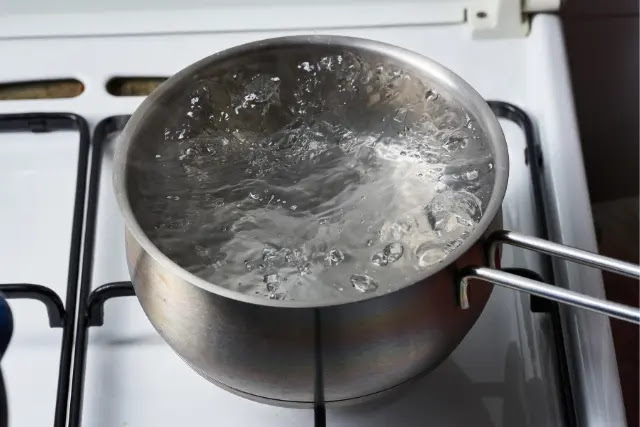Fleas are notorious for being hardy pests, making any infestation a source of great distress for homeowners and pet owners alike. As these tiny intruders set up camp on your pets, bedding, and even in the nooks and crannies of your home, finding an effective way to combat them becomes a priority. The urgency of addressing flea infestations can't be understated; they're not just a nuisance but can lead to conditions such as flea allergy dermatitis. Many homeowners and pet owners have considered the effects of hot or cold water as a potential solution. But does it work? And how exactly?
{tocify} $title={Table des Matières}
Why Consider Water Temperature Against Fleas?
Utilizing water temperature could be a practical solution because everyone has access to hot and cold water, and it's non-toxic, making it pet and environmentally friendly. So, when faced with fleas, is it better to turn up the heat or give them the cold shoulder?
Can Hot Water Kill Fleas?
Absolutely, hot water is not a friend to fleas. These little parasites have a narrow window of temperatures in which they thrive. While they can handle the warmth to some degree, there's a boiling point (pun intended) where they just can't survive. When exposed to temperatures exceeding 100°F, their survival chances drastically decrease.
However, just splashing hot water might not be the most efficient. Introducing soapy water into the mix ensures fleas get trapped, making it even harder for them to escape their heated demise. A bath for your beloved pet in hot soapy water can work wonders, reducing the adult flea population significantly.
And What About Cold Water? Does It Help?
Cold water, on its own, might not be the ultimate flea terminator. However, temperatures plummeting below 40°F can be quite effective. This range is especially brutal to the flea life cycle stages, making it harder for them to reproduce and continue their reign of terror. By strategically utilizing colder temperatures, say, by exposing infested items to winter's chill, you can make a significant dent in the flea population.
How Exactly Does Water Temperature Affect Fleas?
Water temperature doesn't just drown fleas; it messes with their biology. Let's delve a bit deeper into how different water temperatures can spell doom for these pests:
| Temperature | Effect On Fleas | Application |
|---|---|---|
| Below 40°F | Disrupts flea life cycles | Place infested items outside during winter or in cold storage. |
| 40°F – 99°F | Limited effect. Fleas thrive in this range. | Avoid leaving items in this range if possible. |
| 100°F – 140°F | Fleas begin to die. The hotter, the quicker they perish. | Hot baths for pets or washing infested linens in hot water. |
| Above 140°F | Almost instant flea death and sterilization of the environment. | Washing items at this range ensures both flea extermination and cleanliness. |
Why is Cold Water Less Effective but Still Useful?
Cold water, while not as lethal as its hotter counterpart, has its unique advantages. For one, fleas are ectothermic, meaning their body temperature is regulated by the environment. This makes them susceptible to extreme cold, hindering their ability to function properly. In colder environments, fleas become sluggish and their reproductive cycles get disrupted. So, while it might not outright kill them as efficiently as hot water, cold can still be an excellent deterrent, especially in the early stages of an infestation.
How to Make the Most of Hot Water Treatment?
Understanding that hot water is a potent adversary to fleas is one thing, but how can you make the most of it? The first step is ensuring the water's temperature is right. A thermometer can help in ensuring you're in the 100°F - 140°F range which is fatal for fleas.
But don't stop there. Introducing detergent or soap into the equation makes the method even more effective. Why? Because fleas repel water, which is why they can sometimes survive a simple bath. However, soap breaks down this resistance, ensuring the fleas are thoroughly soaked and unable to escape.
For pets, a thorough bath with attention to all areas, especially the neck and base of the tail, can prove fruitful. For household items, washing in hot soapy water and then drying at a high temperature ensures that any lingering pests are dealt with.
What Precautions Should You Take?
While hot water can be a boon in your battle against fleas, it's essential to exercise caution. Ensure the water isn't too hot for your pets, as it might scald them. Always test the water's temperature before exposing your pets to it. Likewise, certain fabrics may not withstand very high temperatures, so always check the care labels on items before washing.
In Conclusion: Hot or Cold - Which is Best?
Both hot and cold water have their roles to play in the fight against fleas. Hot water, with its immediate lethal effects on the pests, especially when combined with soap, can be considered a frontline treatment. Cold water, while not as deadly, can still be an effective tool in disrupting the flea's life cycle and slowing down their activities.
In the end, the most effective approach might be a combination of both. Utilize hot water treatments for immediate relief and thorough eradication, while strategically using cold to manage and disrupt any potential resurgence. Armed with this knowledge, fleas don't stand a chance!


